.
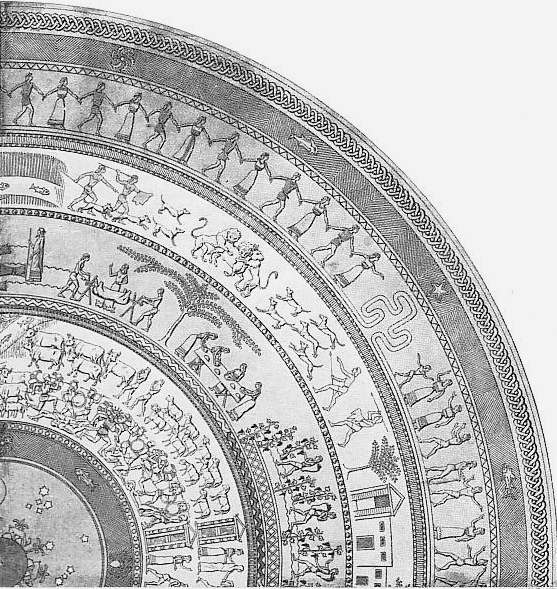
A Reconstruction of part of the Shield of Achilles, See the entire Shield
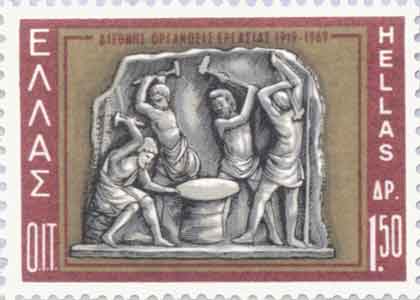
Production of the Shield of Achilles (See the entire image with the helmet and the breastplate and Athena)
The shield of Achilles was richly decorated . Homer provides a lengthy description of the complex scenes with which the shield was decorated: The shield produced by Hephaestus is described in the Iliad, Book 18:
The first thing he created was a huge and sturdy shield,
all wonderfully crafted. Around its outer edge,
he fixed a triple rim, glittering in the light,
attaching to it a silver carrying strap.
The shield had five layers. On the outer one,
with his great skill he fashioned many rich designs.
There he hammered out the earth, the heavens, the sea,
the untiring sun, the moon at the full, along with
every constellation which crowns the heavens—
the Pleiades, the Hyades, mighty Orion,
and the Bear, which some people call the Wain,
always circling in the same position, watching Orion,
the only stars that never bathe in Ocean stream.
Then he created two splendid cities of mortal men.
In one, there were feasts and weddings. By the light
of blazing torches, people were leading the brides
out from their homes and through the town to loud music
of the bridal song. There were young lads dancing,
whirling to the constant tunes of flutes and lyres,
while all the women stood beside their doors, staring
in admiration.
Then the people gathered
in the assembly, for a dispute had taken place.
Two men were arguing about blood-money owed
for a murdered man. One claimed he'd paid in full,
setting out his case before the people, but the other
was refusing any compensation. Both were keen
to get the judgment from an arbitration.
The crowd there cheered them on, some supporting one,
some the other, while heralds kept the throng controlled.
Meanwhile, elders were sitting there on polished stones
in the sacred circle, holding in their hands
the staffs they'd taken from the clear-voiced heralds.
With those they'd stand up there and render judgment,
each in his turn. In the centre lay two golden talents,
to be awarded to the one among them all
who delivered the most righteous verdict.
The second city was surrounded by two armies,
soldiers with glittering weapons. They were discussing
two alternatives, each one pleasing some of them—
whether to attack that city and plunder it,
or to accept as payment half of all the goods
contained in that fair town. But those under siege
who disagreed were arming for a secret ambush.
Their dear wives and children stood up on the walls
as a defence, along with those too old to fight.
The rest were leaving, led on by Pallas Athena
and Ares, both made of gold, dressed in golden clothes,
large, beautiful, and armed—as is suitable for gods.
They stood out above the smaller people with them.
When the soldiers reached a spot which seemed all right
for ambush, a place beside a river where the cattle
came to drink, they stopped there, covered in shining bronze.
Two scouts were stationed some distance from that army,
waiting to catch sight of sheep and short-horned cattle.
These soon appeared, followed by two herdsmen
playing their flutes and not anticipating any danger.
But those lying in ambush saw them and rushed out,
quickly cutting off the herds of cattle and fine flocks
of white-fleeced sheep, killing the herdsmen with them.
When the besiegers sitting in their meeting place
heard the great commotion coming from the cattle,
they quickly climbed up behind their prancing horses
and set out. They soon caught up with those attackers.
Then they organized themselves for battle and fought
along the river banks, men hitting one another
with bronze-tipped spears. Strife and Confusion joined the fight,
along with cruel Death, who seized one wounded man
while still alive and then another man without a wound,
while pulling the feet of one more corpse out from the fight.
The clothes Death wore around her shoulders were dyed red
with human blood. They even joined the slaughter
as living mortals, fighting there and hauling off
the bodies of dead men which each of them had killed.
On that shield Hephaestus next set a soft and fallow field,
fertile spacious farmland, which had been ploughed three times.
Many labourers were wheeling ploughs across it,
moving back and forth. As they reached the field's edge,
they turned, and a man came up to offer them
a cup of wine as sweet as honey. Then they'd turn back,
down the furrow, eager to move through that deep soil
and reach the field's edge once again. The land behind them
was black, looking as though it had just been ploughed,
though it was made of gold—an amazing piece of work!
Then he pictured on the shield a king's landed estate,
where harvesters were reaping corn, using sharp sickles.
Armfuls of corn were falling on the ground in rows,
one after the other. Binders were tying them up
in sheaves with twisted straw. Three binders stood there.
Behind the reapers, boys were gathering the crop,
bringing it to sheaf-binders, keeping them occupied.
Among them stood the king, a sceptre in his hand,
there by the stubble, saying nothing, but with pleasure
in his heart. Some distance off, under an oak tree,
heralds were setting up a feast, dressing a huge ox
which they'd just killed. Women were sprinkling white barley
on the meat in large amounts for the workers' meal.
Next, Hephaestus placed on that shield a vineyard,
full of grapes made of splendid gold. The grapes were black,
the poles supporting vines throughout were silver.
Around it, he made a ditch of blue enamel,
around that, a fence of tin. A single path led in,
where the grape pickers came and went at harvest time.
Young girls and carefree lads with wicker baskets
were carrying off a crop as sweet as honey.
In the middle of them all, a boy with a clear-toned lyre
played pleasant music, singing the Song of Linos,
in his delicate fine voice. His comrades kept time,
beating the ground behind him, singing and dancing.
Then he set on the shield a herd of straight-horned cattle,
with cows crafted out of gold and tin. They were lowing
as they hurried out from farm to pasture land,
beside a rippling river lined with waving reeds.
The herdsmen walking by the cattle, four of them,
were also made of gold. Nine swift-footed dogs
ran on behind. But there, at the front of the herd,
two fearful lions had seized a bellowing bull.
They were dragging him off, as he roared aloud.
The dogs and young men were chasing after them.
The lions, after ripping open the great ox's hide,
were gorging on its entrails, on its black blood,
as herdsmen kept trying in vain to chase them off,
setting their swift dogs on them. But, fearing the lions,
the dogs kept turning back before they nipped them,
and stood there barking, close by but out of reach.
Then the famous crippled god created there a pasture
in a lovely valley bottom, an open ground
for white-fleeced sheep, sheep folds, roofed huts, and pens.

Crane Dance (Geranos) of Theseus and the Athenian youths (“anamiktos”, young men and women mixed ) on their escape from Crete from the François volute krater, potted by Ergotimos, painted by Kleitias,Archaic Ancient Greek Art, ca. 570 BC, Museo Archeologico, Florence
Next on that shield, the celebrated lame god made
an elaborately crafted dancing floor, like the one
Daedalus created long ago in spacious Cnossus,
for Ariadne with the lovely hair. On that floor,
young men and women whose bride price would require
many cattle were dancing, holding onto one another
by the wrists. The girls wore fine linen dresses,
the men lightly rubbed with oil wore woven tunics.
On their heads the girls had lovely flower garlands.
The men were carrying golden daggers on silver straps.
They turned with such a graceful ease on skilful feet,
just as a potter sits with a wheel between his hands,
testing it, to make sure that it runs smoothly.
Then they would line up and run towards each other.
A large crowd stood around, enjoying the dancing magic,
as in the middle two acrobats led on the dance,
springing, and whirling, and tumbling.
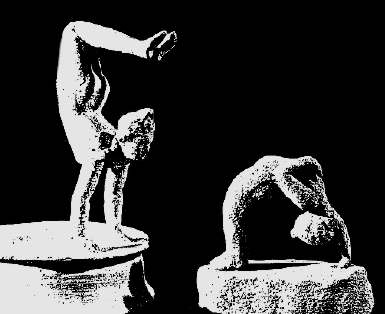
On that shield, Hephaestus then depicted Ocean,
the mighty river, flowing all around the outer edge.
When he'd created that great and sturdy shield,
he fashioned body armour brighter than blazing fire,
a heavy helmet shaped to fit Achilles' temples,
beautiful and finely worked, with a gold crest on top.
Then he made him leg guards of finely hammered tin.
Links
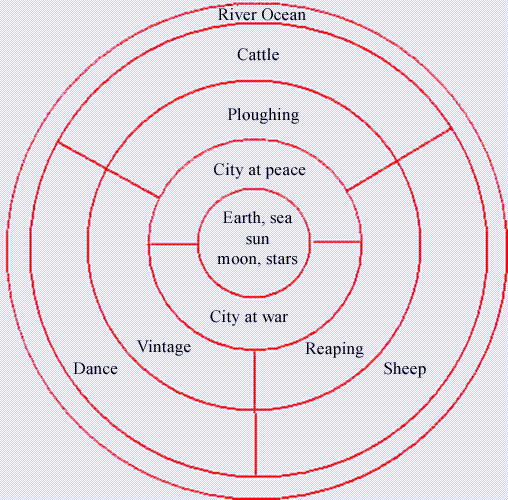
Diagram of the drawings based on : Willcock, Malcolm M., A Companion to the Iliad, University of Chicago Press, Chicago, 1976.
The Shield of Achilles analysis of the text
The Shield and Great Men before Agamemnon
Images
Hephaistos polishing the shield of Achilles, Dutuit Painter c. 480 BC., Red Figure Amphora, Museum of Fine Arts, Boston
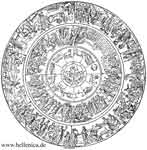
Based on a design of Quatremere de Quincy's work Le Jupiter Olympien ou l'Art de la Sculpture Antique,

See also : Greek Mythology. Paintings, Drawings
| Ancient Greece
Science, Technology , Medicine , Warfare, , Biographies , Life , Cities/Places/Maps , Arts , Literature , Philosophy ,Olympics, Mythology , History , Images Medieval Greece / Byzantine Empire Science, Technology, Arts, , Warfare , Literature, Biographies, Icons, History Modern Greece Cities, Islands, Regions, Fauna/Flora ,Biographies , History , Warfare, Science/Technology, Literature, Music , Arts , Film/Actors , Sport , Fashion --- |
Retrieved from "http://en.wikipedia.org"
All text is available under the terms of the GNU Free Documentation License

